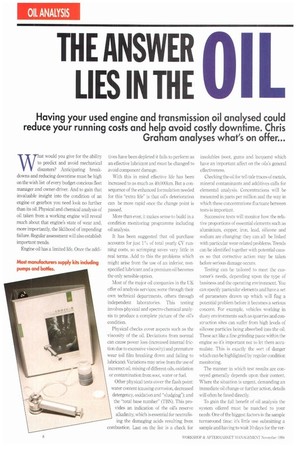THE ANSWER I LIES IN THE V L
Page 102

Page 103

If you've noticed an error in this article please click here to report it so we can fix it.
Having your used engine and transmission oil analysed could reduce your running costs and help avoid costly downtime. Chris Graham analyses what's on offer...
What would you give for the ability to predict and avoid mechanical disasters? Anticipating breakdowns and reducing downtime must be high on the wish list of every budget-concious fleet manager and owner-driver. And to gain that invaluable insight into the condition of an engine or gearbox you need look no further than its oil. Physical and chemical analysis of oil taken from a working engine will reveal much about that engine's state of wear and, more importantly, the liklihood of impending failure. Regular assessment will also establish important trends.
Engine oil has a limited life. Once the addi tives have been depleted it fails to perform as an effective lubricant and must be changed to avoid component damage.
With this in mind effective life has been increased to as much as 40,000km. But a consequence of the enhanced formulation needed for this "extra life" is that oil's deterioration can be more rapid once the change point is passed.
More than ever, it makes sense to build in a condition monitoring programme including oil analysis.
It has been suggested that oil purchase accounts for just 100 of total yearly CV running costs, so scrimping saves very little in real terms. Add to this the problems which might arise from the use of an inferior, nonspecified lubricant and a premium oil becomes the only sensible option.
Most of the major oil companies in the UK offer oil analysis services; some through their own technical departments, others through independent laboratories. This testing involves physical and spectro-chemical analysis to produce a complete picture of the oil's condition.
Physical checks cover aspects such as the viscosity of the oil. Deviations from normal can cause power loss (increased internal friction due to excessive viscosity) and premature wear (oil film breaking down and failing to lubricate). Variations may arise from the use of incorrect oil, mixing of different oils, oxidation or contamination from soot, water or fuel.
Other physical tests cover the flash point: water content (causing corrosion, decreased detergency, oxidation and "sludging"): and the "total base number" (TBN). This provides an indication of the oil's reserve alkalinity, which is essential for neutralis ing the damaging acids resulting from combustion. Last on the list is a check for insolubles (soot, gums and lacquers) which have an important affect on the oils's general effectiveness.
Checking the oil for tell-tale traces of metals, mineral contaminants and additives calls for elemental analysis. Concentrations will be measured in parts per million and the way in which these concentrations fluctuate between tests is important.
Successive tests will monitor how the relative proportions of essential elements such as aluminium, copper, iron, lead, silicone and sodium are changing: they can all be linked with particular wear-related problems. Trends can be identified together with potential causes so that corrective action may be taken before serious damage occurs.
Testing can be tailored to meet the customer's needs, depending upon the type of business and the operating environment. You can specify particular elements and have a set of parameters drawn up which will flag a potential problem before it becomes a serious concern. For example, vehicles working in dusty environments such as quarries and construction sites can suffer from high levels of silicone particles being absorbed into the oil. These act like a fine grinding paste within the engine so it's important not to let them accumulate. This is exactly the sort of danger which can be highlighted by regular condition monitoring.
The manner in which test results are conveyed generally depends upon their content. Where the situation is urgent, demanding an immediate oil change or further action, details will often be faxed directly To gain the full benefit of oil analysis the system offered must be matched to your needs. One of the biggest factors is the sample turnaround time: it's little use submitting a sample and having to wait 10 days for the ver dict. Nnwessing times do vary between manufacturers: it's normally quicker with those who analyse in-house.
Sampling kits arc provided for customers on most schemes. These normally consist of a hand-operated pump for extracting the oil directly from the vehicle, lengths of plastic piping, information labels, sample bottles and cardboard posting tubes (often Freepost). It's important that you identify each sample properly. Every engine, gearbox or axle should be uniquely coded to avoid confusion when the results are processed.
There can be little doubt that embarking on an oil analysis and condition monitoring programme makes sense. The charges made for such a service are normally negotiable and surely represent a price well worth paying as an alternative to the cost of unforseen engine or gearbox failure.






















































































































